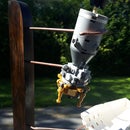Introduction: Perspective Drawing Grid
One of my biggest passions is airbrushing, and as an airbrush artist, I'm often commissioned to scale up smaller images onto larger surfaces. My wife, on the other hand is a perspective type of artist who enjoys finding a real life scene and recording it on paper. Sometimes, it can be difficult, for each of us to get proportions correct, especially when scaling an image. That's where the perspective drawing grid comes in. Now, the drawing grid isn't a new creation. In fact its first recorded use is in hieroglyphs dating back 3000 years. In Victorian times, it was a popular tool with architects and landscapers who wanted to record their work for posterity, but fell out of common use once the camera made an appearance.
It's two-fold use is simple. As a perspective grid, the artist places it in front of their line of sight, and draws a corresponding grid pattern, in light pencil, on the page they're working on. Then the scene they are attempting to recreate can easily be transferred to the page, and the pencil grid erased leaving a perfect duplicate. As a drawing grid, you first lay it on the surface where you intend on putting your image. You then draw the grid on the photograph you want to scale-up.By employing a coordinate system to each square on the grid, I.E. as in the game battleship, you can achieve a perfect duplicate of whatever scene or image you choose.
This design is for a 24"x24" drawing grid with a one square inch grid size. The advantage is that the smaller the grid, the more detail and accuracy, however every second or third hole can be threaded for larger squares.
Step 1: Tools and Supplies
Tools;
- saw - table is preferable
- drill with bits
- Sewing needle
Supplies;
- 1"x3"x24" wood
- 2"x4"x6" block of wood
- string - nylon, dacron, dental floss, etc. Thin strand but stronger than sewing thread.
- sandpaper
- 4 nuts, bolts, washers - 1" long. I used #8 but you can use whatever you have on hand.
Step 2: Cutting Your Pieces
Slice four strips from your 1x3" exactly 3/8" thick using your table saw. If you don't have a table saw, other saws, can be used, but you may find it difficult to get a consistent thickness. You can use pre-cut wood strips from your local hobby shop, but make certain to adjust the sizes accordingly.
Frame Pieces;
Now, when we refer to a piece of wood being 1x3", it's not exactly 1x3", due to the milling process at the lumber yard. The piece I had was rough cut 7/8" thick pine so to ensure that every square was exact, I had to reduce the overall length of my boards to 23 3/4" (losing 1/8"x2 for the shortness of each board).
Standing Block;
The standing block is very simple. I set the saw depth to 1/2" and the guide to cut straight down the length of the board, just off of it's center. I then adjusted the guide so that it widened the cut, making a groove that was slightly larger than my 3/8" pieces.
Step 3: Measuring the Thread Holes
As I said before, my boards were 7/8" wide, so I started by marking that off on each end. This would be where each corner of the square would meet. I then marked every inch between the two end marks, and 1/4" from the one edge using my combination square. I actually only marked one board, taped them all together into a stack and used my drill press to drill them as one piece, but you can drill them individually using a 1/8" bit. It just takes a tad longer. Finally I drilled the exact center of the 7/8" end pieces for my bolts.
Last thing to do, before assembly, is to give all of the pieces a good sanding, rounding the edges and removing burrs. You can use a micro file to clean out the drill holes if necessary, but sanding should take care of that well enough.
Step 4: Bolting and Squaring
Now bolt your ends together. Initially, when I built my first one, I bolted end over end, like an M.C. Escher staircase, but found it never sat very square. It's just best to bolt two boards on the bottom, and the two opposite boards on top. Don't snug the bolts up just yet.
Use your combination square to correct the angles, or if you don't own one, you can just measure corner to opposite corner, in an X pattern and make sure the numbers are the same. That should ensure that it's perfectly squared. Once you're done, you can snug up the bolts.
Step 5: Stringing Your Grid
When you string your grid, you have the option of going every hole, or every other one, depending on the size of the squares you need for your project. There's a few points to be conscious of so rather than a straight explanation, I'll list them for you;
- Always 'weave' the string in an over under pattern. This will help lock them together and prevent the strings shifting while you're working.
- The tips of your bolts should point upwards so that the grid can lay as flat as possible when used as a drawing square.
- only one side of the frame is woven (opposite to the bolt tips), meaning as you weave (example in pic 2). This will keep the strings as flat as possible against your work.
- Use a long needle.
*note* The easiest way to thread is to tie off to one hole, do all of the horizontal runs first, tie it off at the end, then repeat for the vertical. I simply count however many runs per axis, unspool a sufficient amount of thread, then weave as if I were sewing a hole closed on an old pair of jeans.
Step 6: Finished
That's it. Now you're ready to use your drawing grid. To use as a perspective grid, simply sit the edge into the groove you made in the base and your ready to get drawing.
As usual, I hope you enjoyed the instructable and thanks for following.

First Prize in the
Paint It! Sponsored by Olympic Paint

Participated in the
Vintage Contest

Participated in the
Epilog Challenge VI













